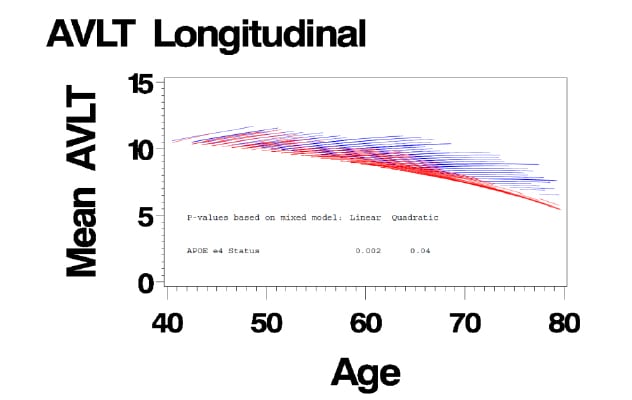Jan. 23, 2021
Mayo Clinic has found that cognitive and behavioral changes can be detected nearly two decades before the onset of Alzheimer's symptoms. That time lag — longer than previously demonstrated — is similar to the gap between preclinical biomarker changes and symptom onset.
"Our work shows that plenty is happening during the preclinical period that needs to be addressed to help prevent dementia," says Richard J. Caselli, M.D., a neurologist at Mayo Clinic in Phoenix/Scottsdale, Arizona. "It's never too early to try to avoid setting up the cascade of events that will kick in, on average, by our early 50s."
Mayo Clinic's finding, described in the March 2020 issue of Alzheimer's & Dementia, is one of many insights from an extensive study of neuropsychological aging underway at Mayo Clinic since 1994. Cognitively healthy adults age 21 and older in Maricopa County, Arizona, are recruited for the longitudinal study.
Participants have initial genetic testing to gauge their relative risk of developing Alzheimer's disease, as well as neuropsychological testing that is repeated every two years. Some participants also have MRI and PET imaging, performed in conjunction with Banner Alzheimer's Institute in Phoenix.
Mayo Clinic is one of the few centers conducting longitudinal personality-based testing as a potential aid for identifying the transition from cognitive health to mild cognitive impairment (MCI) in individuals at risk of dementia.
"We have found subtle but statistically significant differences in personality that coincide with the transition from preclinical Alzheimer's disease to incident MCI," Dr. Caselli says. "During that transition, we see an increase in neuroticism and a decrease in openness, along with subclinical behavioral measures of somatization, depression, anxiety and irritability."
The genetic component of the longitudinal research, focused particularly on the APOE e4 allele, aims to identify and quantify an individual's risk of developing Alzheimer's disease. An early key finding was that age-related memory decline in carriers of that allele diverges from age-related memory decline in noncarriers before the age of 60.
Genetic component of memory decline

Genetic component of memory decline
Graph shows the more rapid decline in memory experienced by APOE e4 carriers (red) compared with noncarriers (blue). Each line represents an individual patient in Mayo Clinic's longitudinal study.
All of this work has facilitated the design of trials aimed at preventing dementia. "Sadly, we still don't have a therapy known to be effective for dementia. But unlike 20 years ago, we now have preventative trials," Dr. Caselli says. "Because of the length of our study and the wide age range of our cohort, we are able to help researchers determine what should be measured and when it should be measured."
Complex pathogenesis
Mayo Clinic's research has contributed to the increasing awareness of the complexities of dementia pathophysiology. "There are a number of both inherited and acquired factors that increase our vulnerability and that don't seem to conform to any single pathway," Dr. Caselli says. In addition to APOE e4, roughly 30 other genes have a milder but statistically significant effect on dementia risk. Acquired and environmental risk factors include head injury and air pollution.
The 2020 study of early cognitive and behavioral changes assessed neuropsychological changes in an APOE e4-enriched cohort of individuals. All members of the cohort were cognitively normal when they entered the longitudinal study. Among individuals who went on to develop MCI, behavioral measures changed in the pre-MCI period — despite the absence of any clinically identified behavioral problems. Depression also tended to increase more rapidly in individuals who went on to develop MCI compared with participants who didn't.
"During the transition from normal aging to MCI, there is a change in personality and behavioral measures, including depression scores," Dr. Caselli says. "This temporal pattern suggests that depression, rather than being a risk factor, is more likely an early manifestation of neurodegeneration."
Amyloid buildup, long considered the first in a linear sequence of events leading to dementia, has now been shown to occur at the same time as tau formation, brain atrophy and memory decline. In a theoretical article published in the November 2020 issue of Alzheimer's & Dementia, Mayo Clinic researchers proposed an alternative to the amyloid cascade hypothesis: that amyloid formation is part of the brain's protective response to various genetic and environmental neurotoxic factors.
The researchers noted that amyloid precursor protein, which leads to the production of amyloid beta plaques, is vital for brain development and structure and has a diverse array of functions. The researchers suggest that dysregulation of this complex system might include, yet go well beyond, amyloid beta accumulation and toxicity. Similar proposals made by other investigators haven't received sufficient merit, according to the Mayo researchers.
The updated amyloid hypothesis aligns with the findings of Mayo Clinic's neuropsychological research. "We see people starting to develop cognitive decline right from the beginning. We don't have to wait for the amyloid buildup," Dr. Caselli says.
The complexities of Alzheimer's disease pose significant challenges for researchers, clinicians and patients. But as a clinician-researcher, Dr. Caselli emphasizes that for most people, cognitive decline is a long process that needn't preclude activity. He cites a patient who, after a diagnosis of MCI, fulfilled his lifelong dream of hiking the 800-mile Arizona Trail alone. "Even for people who have MCI, life isn't over yet," Dr. Caselli says.
For more information
Caselli RJ, et al. Neuropsychological decline up to 20 years before incident mild cognitive impairment. Alzheimer's & Dementia. 2020;16:512.
Banner Alzheimer's Institute.
Caselli RJ, et al. An agnostic reevaluation of the amyloid cascade hypothesis of Alzheimer's disease pathogenesis: The role of APP homeostasis. Alzheimer's & Dementia. 2020;16:1582.